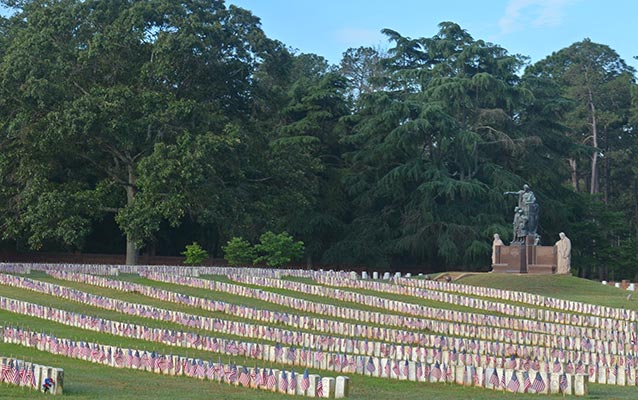Last updated: January 21, 2023
Lesson Plan
August Anguish at Andersonville: An Elementary Math Lesson

- Grade Level:
- Upper Elementary: Third Grade through Fifth Grade
- Subject:
- Math,Social Studies
- Lesson Duration:
- 60 Minutes
- Common Core Standards:
- 4.NF.3, 4.MD.1, 4.MD.2
- State Standards:
- Georgia Social Studies Standard SS8H6 The student will analyze the impact of the Civil War and Reconstruction on
Georgia. - Additional Standards:
- NATIONAL/STATE STANDARDS:
CCGPS Mathematics (4th Grade)—CC4.MD.1
CCGPS Mathematics (5th Grade)—MCC5.NF.3
CCGPS Mathematics (6th Grade)—MCC6.RP.3 - Thinking Skills:
- Understanding: Understand the main idea of material heard, viewed, or read. Interpret or summarize the ideas in own words. Applying: Apply an abstract idea in a concrete situation to solve a problem or relate it to a prior experience. Analyzing: Break down a concept or idea into parts and show the relationships among the parts. Evaluating: Make informed judgements about the value of ideas or materials. Use standards and criteria to support opinions and views.
Essential Question
Missing
Objective
How can I as a historian use fractions and percentages to explore and better understand the Andersonville prison during the Civil War?
Background
After the breakdown of the prison exchange system in mid 1863, both Union and Confederate forces were forced to hold prisoners for an extended period of time.
The Confederacy first held Union prisoners in the capital city of Richmond, VA, but this placed a tremendous strain on the city’s resources. So in early 1864 the Confederacy built a new prison in rural Georgia – Camp Sumter, which quickly became known as Andersonville.
By the summer of 1864 Andersonville was incredibly overcrowded. Approximately 33,000 prisoners were held in a space intended for 10,000 and diseases related to sanitation and nutrition were rampant. By the time the prison ceased operation 45,000 men passed through the prison gates, and 13,000 of them died, making Andersonville the deadliest ground in American history.
It can sometimes be difficult for students to grasp to scale of suffering at Andersonville. This activity provides an opportunity for students to apply math skills and get a better sense of the overcrowding and death that occurred in August of 1864, when the prison was at its maximum population.
Preparation
*Decide whether the activity will be completed independently, in pairs, or in groups.
*Make one copy for each student of the “Size and Scale of Andersonville”, “Reflections”, and “Extension”
*Students will need pencil and possibly a calculator
Materials
Use to complete math activity.
Download Consolidated Monthly Returns, August 1864
Use to complete math activity.
Use to Complete Math Activity.
Download Daily Returns, August 1864
Complete as an extra challenge to apply Andersonville comprehension at a higher-level.
Lesson Hook/Preview
Choose one of the following lesson hooks:
- Request a copy of "Voices from Andersonville," a 30 minute introductory film to the Andersonville story
Procedure
- Review with students the appropriate mathematical skills that they will need.
- Distribute to each student or group a copy of the age appropriate worksheet of “The Size & Scale of Andersonville”
- Distribute copies to each student or group copies of the following:
- “Map of Andersonville Prison”
- ”Daily Returns, August 1864
- “Consolidated Monthly Return, August 1864
4. Give students time to work through the assignment.
5. Using your answer key, go over the procedures with the students and help them solve each of the problems.
6. Discuss with students what these statistics mean. Ask students to answer the “Andersonville Reflection Questions” independently.
7. Hand out the “Extension Activity” directions. Ask students to choose one of the extension activities to complete or propose a different extension activity.
8. If time and budget permit, consider taking a field trip to Andersonville.
Vocabulary
Fraction – A quantity that is not whole
Numerator - the number above the line in a fraction showing how many of the parts indicated by the denominator are taken, for example, 2 in 2/3.
Denominator - the number below the line in a common fraction showing the divisor representing the total quantity, for example, 3 in 2/3
Assessment Materials
Size and Scale of AndersonvilleUse the “Size and Scale of Andersonville” activity as an assessment of math skills.
Size and Scale of Andersonville
Rubric/Answer Key
Size and Scale of AndersonvilleUse to check comprehension of math skills and historical understanding.
Size and Scale of Andersonville KEY
Supports for Struggling Learners
*Heterogeneous pairs for the activity
*Use of a calculator
Enrichment Activities
*Higher-level math versions of this activity are also available. Search for either “August Anguish at Andersonville – Middle School” or “August Anguish at Andersonville – High School”.
Additional Resources
American Red Cross, Exploring Humanitarian Law Curriculum. www.redcross.org/ehl
Banfield, Susan. The Andersonville Prison Civil War Crimes Trial: A Headline Court Case. Enslow Publishers, 2000.
Cloyd, Benjamin. Haunted by Atrocity: Civil War Prisons in American Memory. LSU press, 2010.
Futch, Ovid. History of Andersonville Prison. University of Florida Press, 1968.
Leonard, Elizabeth D. Lincoln's Avengers: Justice, Revenge, and Reunion After the Civil War. W. W. Norton & Company, 2004.
Kellogg, Robert H. Life and Death in Rebel Prisons. Hartford, 1865.
Marvel, William. Andersonville: The Last Depot. University of North Carolina Press, 1994.
The Trial Of Henry Wirz, 1866. https://go.nps.gov/wirztrial
Witt, John Fabian. Lincoln’s Code: The Laws of War in American History. Free Press, 2012.
Related Lessons or Education Materials
*August Anguish at Andersonville: A Middle School Math Lesson
*August Anguish at Andersonville: A High School Math Lesson
